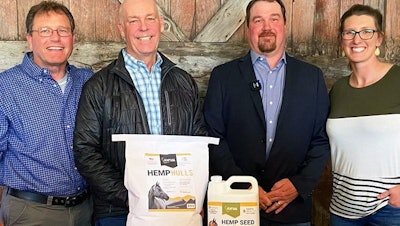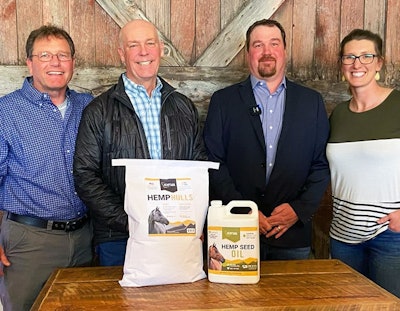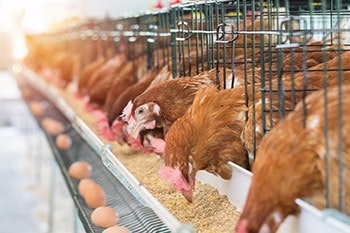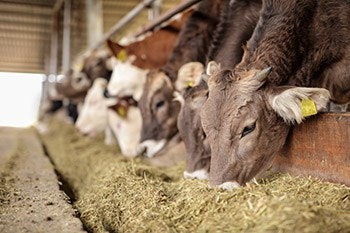

The objective was straightforward: to gain approval for hemp and its byproducts as animal feed to unlock market opportunities for farmers and rural communities.
When IND HEMP, a Fort Benton, Mont.-based industrial hemp oilseed and fiber company representing 30-plus family farmers in Montana, coordinated with hemp lobby firm Agricultural Hemp Solutions (AgHS) to pass state legislation clarifying hemp food ingredients in the definition of commercial feed, drawing a clear picture for state lawmakers was key in gaining support.
In short, hemp feed ingredients have not received approval or guidance from the U.S. Food and Drug Administration (FDA), although hemp food products like oil, protein and hearts have generally recognized as safe (GRAS) product notices submitted with no concern from FDA.
Without clear guidance on hemp feed from the FDA, there are some hemp-related products on market already engaging in this gray area of commerce, IND HEMP Chief Operating Officer Morgan Elliott said.
“We had an opportunity to launch a product with a customer that wanted to operate in the black and white,” she said. “And [that’s] when we went to our department of agriculture to try and find out, how is that possible?”
When the Montana Department of Agriculture advised that it acts on behalf of what state legislation authorizes it to regulate through the lawmaking process, IND HEMP turned its gears toward talking with state representatives and testifying in front of House and Senate committees, Elliott said.
The more Elliott and her team—which includes her father, Ken Elliott, who owns IND HEMP—worked on shaping public policy in Montana, the more they learned how off the radar their objective to advance hemp as animal feed was for lawmakers, she said.
“Letting people know was the first part of it,” the younger Elliott said. “We testified at both the House committee hearing and the Senate committee hearing, and the overwhelming response [was] ‘This is an issue?’ Like, ‘I didn’t even know about it. I can’t believe it.’

Sponsored by Rep. Josh Kassmier, R-Fort Benton, House Bill 396, “An Act Clarifying the Definition of Commercial Feed to Include the Use of Hemp Products,” was passed nearly unanimously by the Montana Legislature and was signed into law by Republican Gov. Greg Gianforte on April 11. The bill drew the support of 147 state lawmakers with only one “no” vote between both chambers of Congress.
In addition, the legislation also had active support from the Montana Farm Bureau, Montana Farmers Union, Montana Stockgrowers Association and Montana Grain Growers Association, according to an IND HEMP press release following Gianforte’s signing.
AgHS Chief Legislative Strategist Courtney N. Moran, who lobbied for the bill’s passage alongside IND HEMP, commended the company’s work in finding widespread backing for the legislation.
“H.B. 396 is a positive and necessary step forward in recognizing hemp as an agricultural crop,” Moran said. “Opening the door for hemp as a commercial feed ingredient creates new markets for farmers. I’m proud to work with IND HEMP in advancing industrial hemp grain and fiber policy and infrastructure development.”
Specifically, the new law provides authority for hemp’s use as commercial feed for horses, pets and specialty pets, such as gerbils, hamsters, birds, fish, snakes and turtles. For other livestock, effectiveness of the law is contingent upon FDA-Center for Veterinary Medicine (CVM) approval of hemp as an additive or defined ingredient in animal food or medication feed for livestock.
In hindsight, Elliott said IND HEMP’s efforts to advance hemp as animal feed probably should have included all livestock that isn’t destined for the human food supply chain and its byproducts—such as calf-cow pairs or any animal for rodeo operations, like bulls or breeding stock.
“But we were just trying to get this first thing approved,” she said. “We want to play [by the rules] with FDA-CVM. We appreciate their stance on products that are going into human consumption. It does require the due diligence that they’re asking, but everything else … there should be [a] free market for us to engage in.”
Under the 1958 Food Additives Amendment to the FD&C Act, any substance intentionally added to food is a food additive and is subject to pre-market approval by FDA unless the use of the substance is GRAS. Elliott said hemp should have been a commodity that was grandfathered in and recognized as a safe nutritional feed product because it was in commerce before prohibition. Hempseed products has been well documented throughout history as a relatively inexpensive and nutrient-rich ingredient for both humans and animals.
RELATED: Hemp's Potential in the Animal Feed Market

IND HEMP helped support the Hemp Feed Coalition (HFC), which submitted a new ingredient definition request to the Association of American Feed Control Officials (AAFCO) last year in an effort to advance hempseed meal for laying hens. Once the AAFCO reviews the request, the association will forward it to the FDA-CVM for final approval, HFC Executive Director Hunter Buffington said.
“The approval process can take up to four years; but the FDA-CVM has agreed to fast-track the process for hemp [to] 18-24 months per application,” Buffington said. “We have a ways to go, but the first one is always the hardest and we are working on our next submissions now.”
RELATED: Hemp Feed Coalition Makes Inroads on Including Hempseed in Chicken Feed
Elliott said the slow nature of FDA along with the business-prohibitive requirements the agency has in place motivated IND HEMP to try another path and utilize the legislative process.
“Our success with state legislation put the fire under them [FDA-CVM] a little bit that, like, we’re going to be moving forward [and hopefully they catch up],” she said. “We’re not trying to be difficult; we’re trying to do things the way that they want it to.”
Elliott added that the FDA-CVM needs to meet industry stakeholders in the middle in order to help them find a way to create value in the struggling ag communities.
“[We] don’t want to butt heads with the government,” she said. “It’s just, we need to apply pressure that when you [put off doing] your job, it forces our hand.”
Other states are now moving to follow Montana’s lead.
In Texas, state lawmakers passed House Bill 3948, which aimed to create a licensing process for Texas farmers to use hemp feed. However, the Senate added language to the bill in an effort to attach limits for delta-8 tetrahydrocannabinol (THC) products.
With the two chambers of Congress having conflicting versions of the bill, House sponsor Rep. Tracy King decided to go to a conference committee. The authors did not come to an agreement on their differences before the Legislature adjourned May 31. The bill is now dead.

As drought conditions have affected much of Texas, Oklahoma and Kansas during the past year, cattle producers have struggled to preserve their herd sizes with supplemental feed, and low cattle prices have made herd reductions less attractive.
While importing feed from other countries may be one option, gaining federal approval for hemp and its byproducts as animal feed is an in-country solution, when millions of acres of hay and alfalfa are compromised by weather conditions in the U.S., Elliott said.
As farmers struggle to feed their livestock, Elliott said, “It’s really frustrating because we have a really nutritious product that we know is safe, [and] we know is a good, viable [feed source] that even can be economical for some of these guys.”
While Texas lawmakers weren’t successful in enacting a pathway for hemp feed this legislative session, there were eight state departments of agriculture that contacted Montana’s department within 24 hours of Gianforte signing H.B. 396, in an effort to understand the new law and how they could enact similar advancements, Elliott said.
The objective of H.B. 396 was single-focused, and lawmakers responded with overwhelming support. Backing the bill with his co-sponsorship, Sen. Tom Jacobson, D-Great Falls, said Montana’s agricultural future depends on the growth and diversification of hemp.
“Businesses such as IND HEMP are developing a completely new industry in our state and we as a legislature need to do whatever we can to reduce barriers and provide opportunities for growth,” he said.
As new market opportunities continue to knock on the door for hemp industry stakeholders, the elder Elliott established a full-scale hemp processing facility in 2019 in Fort Benton, enabling his team to process between 15,000 and 20,000 acres of grain per year. In addition, IND HEMP is building a fiber line that can process between 30,000 and 40,000 acres.
When the Agriculture Improvement Act of 2018 (the 2018 Farm Bill) was signed into law, setting the stage to push state-by-state programs out of pilot mode and into full-on, federally regulated production, a lack of infrastructure in many states has held back market opportunities in the fiber and grain segments of hemp cultivation.
But advancing hemp as animal feed, complemented by processing capabilities, has positioned Montana hemp cultivators to work toward reaching their production potential. When product values go up, favorable commodity pricing and new market opportunities can trickle down for growers, Elliott said.
“Once again, Montana provides the right kind of leadership to get business done in these uncertain times,” the elder Elliott said in April, when H.B. 396 was signed into law. “Leadership that is bipartisan and helps our farmers and our rural communities. In Montana, we look forward to building a nationally recognized hemp program founded on grain and fiber production and working with those farmers and businesses who work hard to make things happen.”
“The Texas bill [had] some language in there for federal funding, it had some research language in there, it had some commodity language, and they’re all super great things that as a whole help our industry on the grand scale of things,” Elliott said. “And we sacrificed [all of those great things for some flash-in-the-pan product like delta-8].”

























